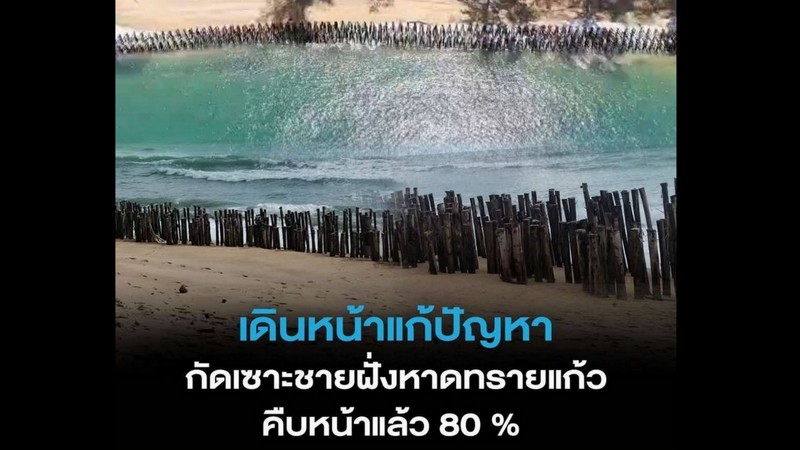Sirawat Suebsai, a forestry expert and acting head of Sirinat National Park, revealed that the ongoing project ‒ funded by the national park budget for the 2024 fiscal year at a cost of B4.789 million ‒ aims to protect one of the park’s most critical erosion zones.
The initiative includes the construction of a 500-metre-long zigzag wooden sand trap fence designed to slow erosion, promote sand dune formation and serve as a buffer against wave energy.
In addition to the fence, beach vegetation is being planted behind the structure to form a ‘green wall’ whose root systems help stabilise the shoreline. Plants include sea purslane, sea urchin, sea pandanus, sea hyacinth and Indian almond. The entire first phase is expected to be completed by this August.
Natural Resources and Environment Minister Dr. Chalermchai Sri-on and Department of National Parks Director-General Atthaphon Charoenchansa earlier this month visited the site to inspect progress. Following the visit, Phase 2 of the project was given the green light.
Phase 2 will expand on the initial work by installing an additional zigzag fence running parallel to the first, along with two more wooden fences stretching 1,150m each along other vulnerable parts of the coastline. A budget request of B5.85mn has been submitted for fiscal year 2025 to support the second phase.
Mr Sirawat stressed the importance of closely monitoring coastal changes. Recent studies found that Sai Kaew Beach is experiencing the most severe erosion in the park, with the shoreline retreating horizontally by up to 7.35m and vertically by as much as 2.42m. Tidal currents and strong waves continue to carry away sediment, in some cases toppling pine trees and pushing seawater over roads during storms.
“If left unaddressed, erosion could sever the main exit road from Phuket within three to four years, which would significantly impact the province’s economy,” he warned.
Sirinath National Park is Phuket’s only marine national park and spans 90 square kilometres along Phuket’s northwest coast.. It includes pine forests, white sand beaches, coral reefs and habitats for sea turtles and rare marine species. In addition to a large section of Nai Yang Beach, key beach areas include Tha Chatchai, Sai Kaew Beach and Mai Khao Beach, covering a continuous 13-kilometre stretch of coastline.
Monitoring of the situation is continuing as sandbars begin forming between the mainland and nearby islands, signaling early signs of recovery, Mr Sirawat said.








